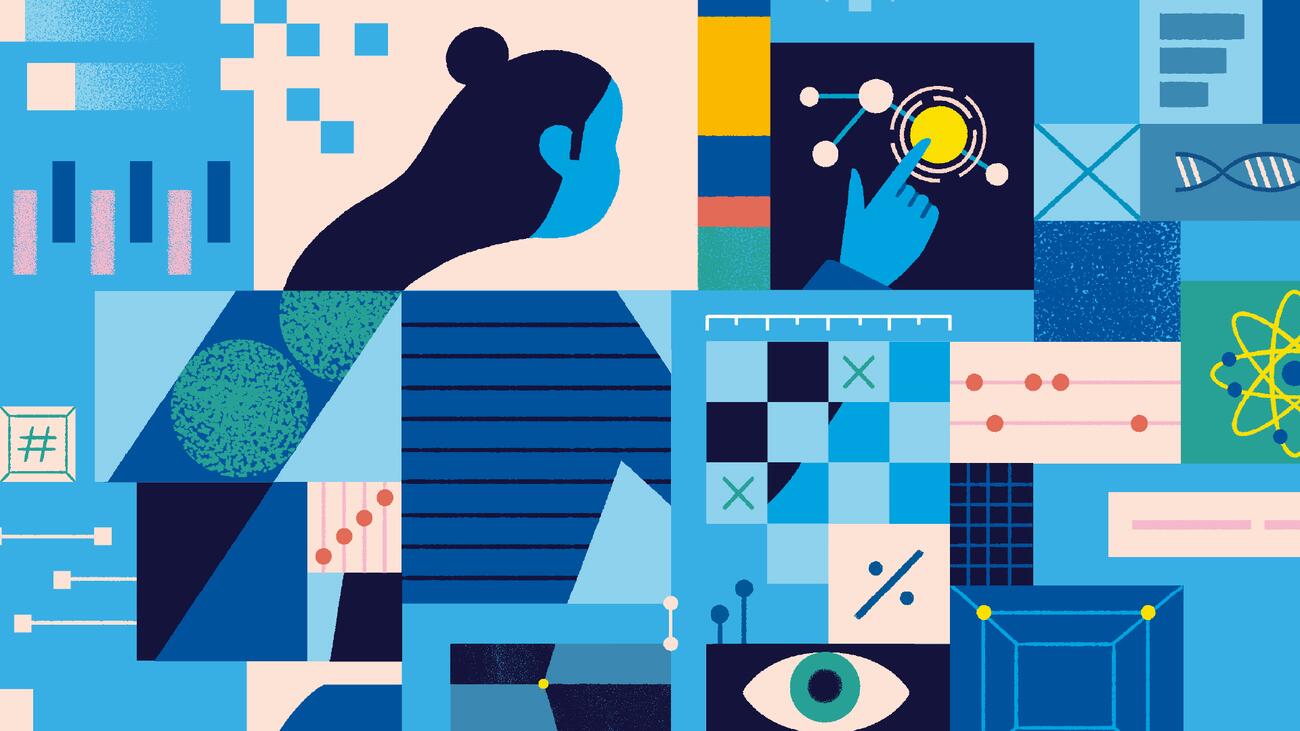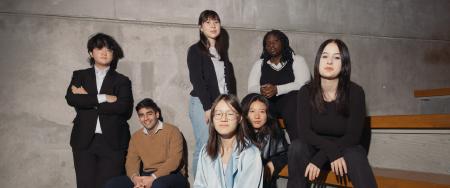
Illustration by Beatrix Hatcher
A learning renaissance
Potent new technologies are redefining education, offering both exciting possibilities and daunting challenges.
What if Shakespeare were infinite?
What if, instead of suffering a limited inventory of plays and sonnets, we could commission a digital bard to generate entirely new works on demand – a tool that can access the whole of his published works, the historical records of the period, the centuries of literary criticism since, and principles from adjacent academic domains such as theatre, psychology, and communications, and then synthesize that information to relate in perfect iambic pentameter an alternate ending where Romeo and Juliet live happily ever after?
Where would these equally masterful works fit in the canon – and in the curriculum?
For some, this is a terrifying deviation from traditional forms of knowledge. For others, it’s a grab bag of opportunities to learn beyond what is taught, even to redefine knowledge as not just a collection of facts, but, as Bruce Lee put it, “a continuous state of inquiry without conclusion.”
Mastering the tools
Welcome to the rapidly changing classroom, where generative artificial intelligence (AI) is just the latest in a quick succession of technological changes that have redefined the day-to-day operations of the learning space, remaking the classic trio of reading, writing, and arithmetic into querying, coding, and data analysis.
Whether this growing cadre of machine-driven classroom tools will serve our existing educational model or create an entirely new type of inquiry is only beginning to play out. But as the rate technology adapts to us begins to outpace the rate we can adapt to it, the Gen Z classroom is becoming less about processing information and more about learning the tools that process information for us.
“All of us are required to be continually learning because the tools themselves are changing at a pace that it’s almost impossible to keep up with,” says David Vogt, who teaches Ventures in Learning Technologies for UBC’s Master of Educational Technology program. “But I think that toolbox is stimulating what I would call a New Renaissance. All of these students having access to all of these tools is going to unleash a flood of creativity such as we probably have never seen before in the history of humanity. That’s a very exciting, but daunting, world to live in.”
Today’s students have to do more than learn these tools; they have to maintain a critical mindset when using them. Their parents and grandparents had no cause to worry about the ethical implications of punching keys on a calculator or typewriter, but as Gen Z endures the first wave of generative tools – machines that synthesize and create rather than just catalogue and connect – they have to be more than tech literate; they have to be tech-critical as well.
“I feel an obligation for students to have an understanding at least in a broad sense of what kinds of technologies will be pertinent to their careers and what kinds of technologies might affect their clients, and am trying to introduce them to the ways that automation might be relevant to legal practice,” says Kristen Thomasen, professor at UBC’s Allard School of Law. “What is really significant here? What’s actually different compared to all the technologies that we’ve grown up with and that we’re used to?”
Whether it’s pushing a cog or preparing a legal brief, automation redefines the purpose of a workplace from one of craft to one of assembly. As intellectual tasks are increasingly offloaded to machines, today’s students are preparing to be tomorrow’s workers, learning less about the technical minutiae of their profession and more about how to oversee the machines that will be performing those tasks for them.
In her course Law, Robotics, and Society, Thomasen explores how this new wave of intellectual automation requires students to understand the promises and pitfalls of smarter tech, a concept Gen Z – as the first crop of digital natives – seems to have been preparing for their whole lives.
“This generation of students has a very nuanced understanding of new technology,” says Thomasen. “Students recognize the importance of being adept in using new technologies. But I also think having grown up with social media in a way that other generations did not, they are very attuned to the individual and political consequences of ever more pervasive tech.”
Integrating the tools
Today’s classroom serves as a living laboratory to experiment with these sea-changes in technology, with students often leading the way. About the same time Gen Z found themselves sidelined by the pandemic and diving into remote learning, they were gaining access to early versions of ChatGPT – the “deep-learning” artificial intelligence that uses layered neural networks to process and learn from vast amounts of data. Just as the rise of the synthesizer in the 70s turned every pianist into an orchestra, AI in the 2020s is turning every student into a polymath.
“In 2020 the technology was ready to be integrated in a coursework setting, but it was mostly spearheaded by students,” says Ioan “Miti” Isbasescu, head of Software Systems in the UBC Engineering Physics project lab. In his course Machine Learning for Robotics, Isbasescu asks students to use these tools to create a literature review on a topic of their choice. He was surprised by the breadth of interests his students were able to exhibit once they had access to these digital personal assistants.
Just as the rise of the synthesizer in the 70s turned every pianist into an orchestra, AI in the 2020s is turning every student into a polymath.
“Students discussed topics as broad as how to establish the location of exit doors in a cinema to prevent a stampede, to deep fake generation and detection of political figures, to generating never-ending videos of landscapes, to creating music when you don’t have any musical abilities, to discovering new properties of materials, and even how to attack neural network systems to undermine someone’s use of them. And large language models are just one tool students are exploring – their toolbox is growing and overflowing with new tools.”
Upending the traditional fear that students will use AI to help them with their homework, Isbasescu has accepted its inevitability. Instead of putting the onus on students to avoid using generative tools to write assignments, he changed how the assignments are evaluated. He traded graded homework for weekly interviews, ensuring that students can communicate what kind of code they developed and how deeply they understand its function.
This year, Isbasescu is experimenting with an AI teaching assistant, using it to explore core concepts of the class and to provide code that would normally be written by the students, such as generating mathematical functions to govern repetitive tasks. “I knew that going into the workforce after they graduate, they would be using these tools,” adds Isbasescu. “And I thought, okay, this is a very good opportunity to get a taste for the tools, and it’s also a good springboard for us discussing all these ethical implications of them.”
To his surprise, Isbasescu discovered a human teaching assistant was needed to oversee the artificial one – a “handler” of sorts who is an expert in the subject matter being taught. The handler spots mistakes made by the AI, and then uses these errors as teaching moments, giving students opportunities to understand the subject matter even more deeply by recognizing and correcting these mistakes themselves.
“There’s this whole idea of AI alignment,” says Isbasescu. “In the beginning, the AI will be aligned with the truth, or what we perceive as being truthful. But then further and further into the curriculum, it is probably going to start diverging from the truth in most classrooms, because AI outputs are not aligned with telling the truth as much as they are aligned with keeping the audience engaged in the conversation. This is where an expert needs to weigh in on the accuracy of the statements, so the AI has to be supervised by an expert in the domain.”
Keeping up with the pace
While this new wave of game-changing technology puts a great deal of power into the hands of the student, it isn’t as democratic as it might seem. As in any classroom, students who master the tools have an easier time mastering the work. Since the tools of generative intelligence cut across all academic fields, the best-performing students will be the ones who can keep up.
“The technology development is accelerating, and there is a real problem that many of the students will be left behind,” says Isbasescu. “The top students are becoming fluent at integrating these tools in their work, benefiting dramatically, while other students are feeling overwhelmed.“
It’s not a stretch to imagine a near future where the traditional classroom does not exist at all, the education system itself replaced by a less costly and more productive model of “algorithmic deans” that create personalized educational experiences for each student based on their interests and societal needs.
But whatever scenario is coming, it’s coming at us almost too fast to process, and it’s easy to overlook how much technological turnover Gen Z has already faced compared to previous generations. Though we’re more than half a century into the internet, only in the past decade has the classroom moved beyond using it as a reference work and towards its potential as an immersive experience, ranging from virtual reality tools to personalized learning platforms to the sudden shift to remote learning brought on by the pandemic.
It has also been about a decade since microchip technology, the accumulation of digital information, and open-source sharing have been brought together to catapult artificial intelligence to the forefront of education – a change that even digital natives might not be prepared for.
“My experience watching many generations engage with emerging technologies is that every new generation tends to embrace the technology of the day, but this doesn’t necessarily build any propensity for them to embrace the next generation’s technology,” says Vogt. “We need to remember there were earlier, less-intense precursors of ‘digital’ generations with home computers, calculators, and even television and radio. I don’t expect that a generation immersed in social media will automatically adopt or demand AI because of that immersion. They’ll be just as existing-technology-bound as previous generations. This is where Gen Z, like every preceding generation, will feel left behind in the technological dust.”



































